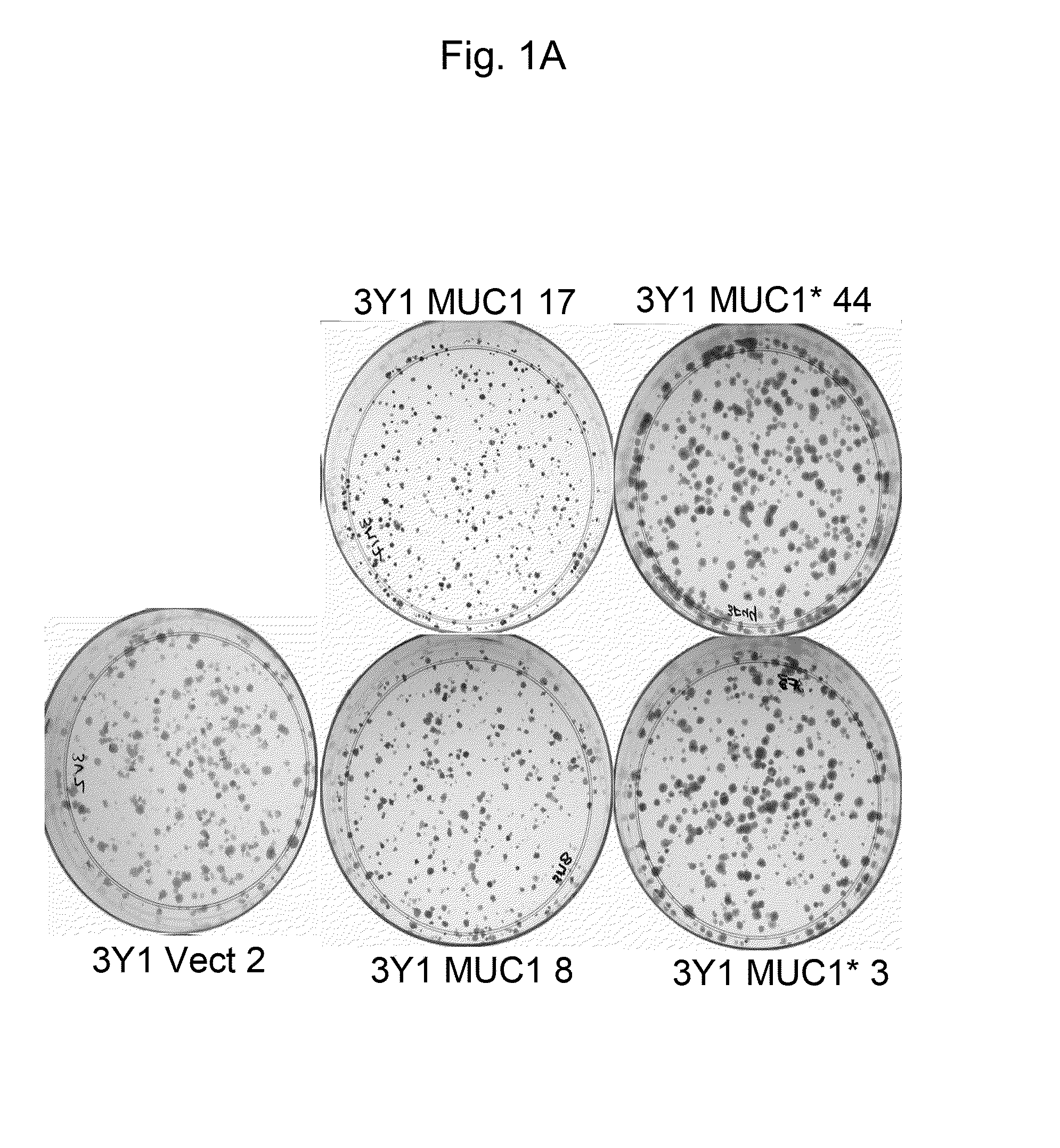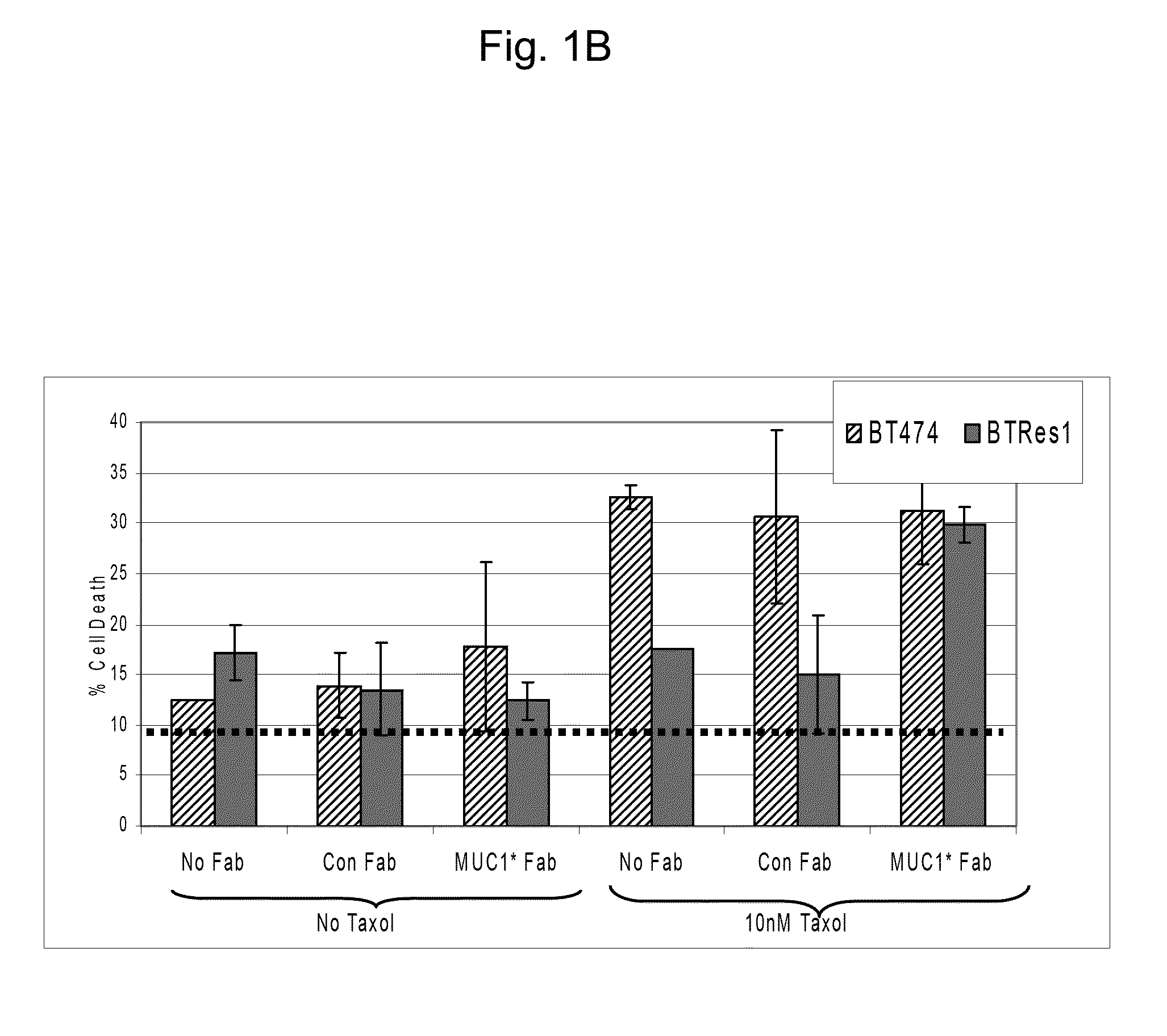Method for inducing pluripotency in cells
a cell and pluripotency technology, applied in the field of cell pluripotency induction, can solve the problems of increasing the risk of oncogenicity, the efficiency of reprogramming was greatly reduced, and the method was extremely inefficient at achieving epigenetic reprogramming, so as to enhance the transcription of muc1, maintain pluripotency, and enhance the effect of muc1 transcription
- Summary
- Abstract
- Description
- Claims
- Application Information
AI Technical Summary
Benefits of technology
Problems solved by technology
Method used
Image
Examples
example 1
MUC1* Promotes Growth and Cell Death Resistance
[0055]MUC1* promotes clonogenic growth (colony expansion) of fibroblasts. Single cell clones of 3Y1 cells transfected with either full-length MUC1 (SEQ ID NO:1), MUC1*1110 (SEQ ID NO:5) or empty vector were plated at 1000 cells per 60 mm dish in DMEM media containing 10% fetal bovine serum, penicillin / streptomycin and G418 (600 μg / ml). Cells were grown for 9 days and then fixed in 4% paraformaldehyde for 15 minutes at room temperature. Dishes were washed with water and then stained with 1% crystal violet in 70% methanol for 20 minutes at room temperature. Dishes were washed three times with water and allowed to dry overnight at room temperature and photographed. FIG. 1A shows that the amount of crystal violet that is absorbed (an indicator of cell number) is much higher where MUC1* single cell clones #3 and #44 are growing. In contrast, cells that transfected with full-length MUC1 (single cell clones #8 and #17) showed no growth rate in...
example 2
[0056]Anti-MUC1* Fab blocks resistance to cell death by Taxol® in trastuzumab (HERCEPTIN®)-resistant cells (made resistant by culture in 1 ug / ml HERCEPTIN®). Fessler et al., 2009 reported that HERCEPTIN® resistant cells are also resistant to TAXOL®, doxorubicin and cyclophosphamide. As reported, these drug resistant cancer cells achieve resistance by overexpressing MUC1*. The following experiment showed that blocking the PSMGFR portion of the MUC1* extracellular domain reversed acquired drug resistance in cancer cells. Parental (BT474) or resistant (BTRes1) cells were plated at a density of 10,000 cells / well in 96 well plates, 4 wells / condition. The following day, Anti-MUC1* Fab, control Fab, or no Fab were added to cells in the presence or absence of TAXOL® (Paclitaxel Sigma T7191). Two days later, cells were resuspended in 50 μl trypsin, and counted in the presence of trypan blue. Percent cell death was calculated as percent trypan blue uptake. BT474 cells underwent cell death in ...
example 3
[0057]MUC1* acts as a growth factor receptor, and is activated by dimerization of its extracellular domain using an artificial (anti-MUC1* antibody) or its natural ligand, NM23 (NME). MUC1*-positive ZR-75-30 cells, 6000 / well, or control (MUC1-negative) HEK293 cells 4000 / well, were plated in 96 well plates. The following day, zero hour cell counts were taken, and different concentrations of anti-MUC1* antibody or Fab were added in medium with low (0.1%) serum every 24 or 48 hours. After several days of incubation, cells were resuspended in trypsin and counted, and percent normalized growth was calculated. Stimulation of ZR-75-30 cells, shown as a bell-shaped curve, as is demonstrated for ligand-induced growth stimulation, but not HEK293 cells (FIG. 1C). In a similar experiment, using MUC1*-positive T47D breast cancer cells stably transfected with siRNA targeting MUC1, or control siRNA, stimulation of growth only occurred with control-transfected cells, further demonstrating specifici...
PUM
| Property | Measurement | Unit |
|---|---|---|
| concentration | aaaaa | aaaaa |
| concentration | aaaaa | aaaaa |
| concentration | aaaaa | aaaaa |
Abstract
Description
Claims
Application Information
 Login to View More
Login to View More - R&D
- Intellectual Property
- Life Sciences
- Materials
- Tech Scout
- Unparalleled Data Quality
- Higher Quality Content
- 60% Fewer Hallucinations
Browse by: Latest US Patents, China's latest patents, Technical Efficacy Thesaurus, Application Domain, Technology Topic, Popular Technical Reports.
© 2025 PatSnap. All rights reserved.Legal|Privacy policy|Modern Slavery Act Transparency Statement|Sitemap|About US| Contact US: help@patsnap.com



